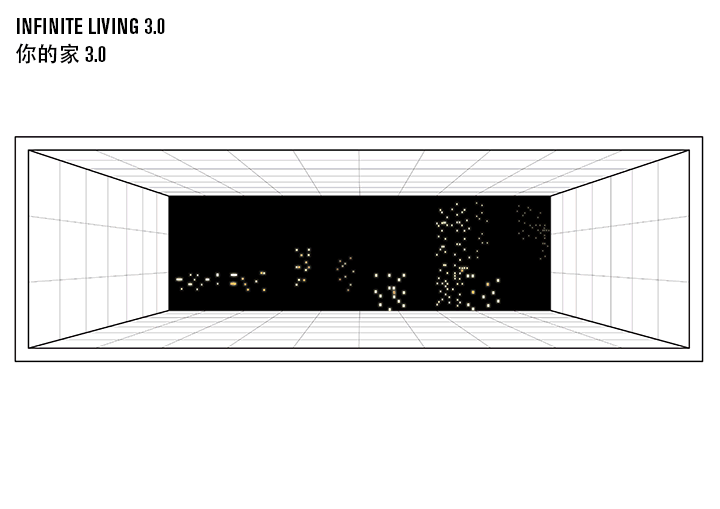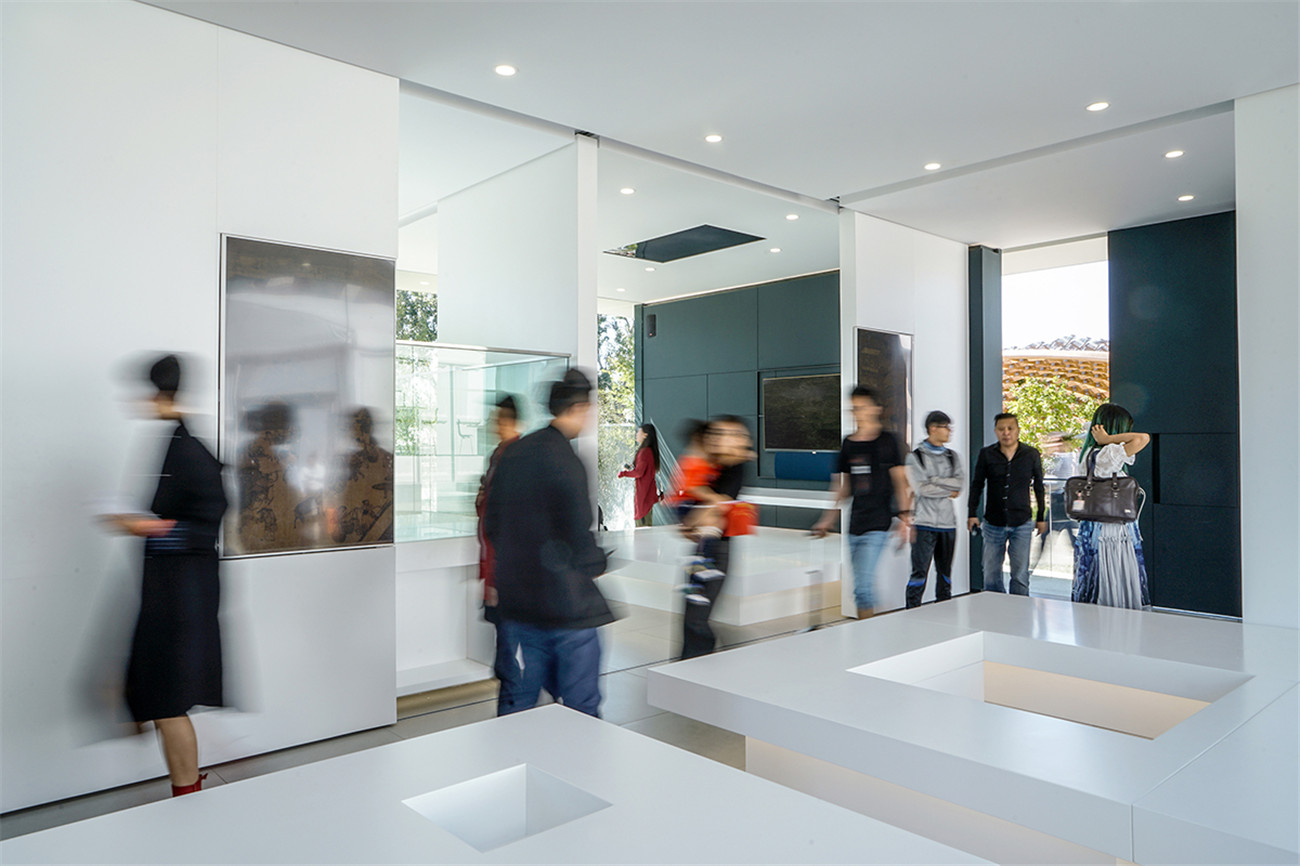Crossboundaries

设计单位 Crossboundaries
展馆位置 中国,北京
展馆面积 100平方米
设计周期 2018年3月—2018年9月
当代中国面临着社会经济的剧变。到2020年,超过60%的人口都将定居在都市地区——较之于1990年的26%,增幅显著。这一迅猛的城镇化进程,伴随着人口密度的暴增,令城市及其人口在应变中承受了巨大的压力。不久的将来,中国大部分人口都将生活在中、高层的住宅楼当中,其简单划一的户型,将日渐难以满足新的家庭单元、数字游民、共享居住或共享办公社群的需求。
Modern China is a place of continuously shifting socioeconomics. By 2020, more than 60% of the population will reside in urban areas – a dramatic increase from the 26% of 1990. This massive urbanization and densification puts tremendous pressure on both cities and citizens to adapt quickly. Soon the majority of people in China will live in mid- or high-rise residential towers, whose standardized layouts will become increasingly unaccommodating for the new nuclear family unit, digital nomad, or co-living / co-working community.

另一方面,新兴的科技也在持续改变着我们生活、工作和出行的方式。物联网的崛起,使得贸易、商业、教育和娱乐活动的发生更加分散化,然而建筑领域的发展,很大程度上却停滞不前。虽然智能家居科技仍受制于软件工业的发展,但声控家用电器已然为我们一成不变的生活方式带来了便利,也潜移默化地影响着建筑发生变化。科技将如何通过居住空间回应个人需求?如何创造一种全新的、更健康、更高效的空间,并基于同样理念在城市肌理层面促生变化?
Emerging technologies, too, continue to change the way we live, work, and move. The rise of the internet of things has decentralized commerce, business, education, and entertainment. However, the building sector remains largely stagnant. Smart home technology has yet been limited to the appliance industry; voice-controlled household electronics add convenience to an otherwise unchanged lifestyle and architecture. How might technology respond to individual needs across living spaces? How could it unlock new, healthier, more efficient spaces, and affect a similarly ideal urban fabric?


Crossboundaries畅想了一种能够更加积极回应人的需求、更灵活多变的住宅——与未来科技相结合,使居住者享受到居住空间的无穷变化。“你的家 / Infinite Living”是一座1:1的住宅模型—— 一个试验性的可变居住环境,也是与“HOUSE VISION探索家”合作一年来的工作成果。HOUSE VISION是由原研哉于2013年在日本发起的、覆盖全亚洲的一个跨学科研究,发展平台。
Crossboundaries imagines a more responsive, changeable home – one that taps into future technologies to allow the residents to infinitely shape their space. Infinite Living is a full-scale housing prototype – an experimental, adaptive living environment and the culmination of a years-long collaboration with HOUSE VISION, the Pan-Asian platform of multidisciplinary research and development initiated and curated by designer KENYA HARA in Japan since 2013. Sponsored by TCL, Infinite Living uses the television as a window to explore new interactions in virtuality.
我们与TCL联合设计的这座展馆,将电视作为联结虚拟与现实的窗口。电视机的角色超越了传统的显示器,成为一个视觉化的中枢,在同一个物理空间内,对应使用者每日的不同需求,可创造出无限种可能的形态,模糊了虚拟与现实世界的界线。这座展馆展现出这样一种场景转换:电视不再是家庭成员聚集的单一焦点,而是一组将人及其需求作为家庭核心的设备,就像万花筒一样,以各种面貌和功能充盈在整个空间中。每台电视都可变为一个交互界面,将现代移动设备的各种功能植入日常生活的空间里。
As a visual portal, television can transcend the monitor, create infinitely many spaces within and beyond itself, respond to everyday needs, and break through the increasingly blurred line between the virtual and the actual. Like a kaleidoscope, the pavilion envisions the television not as a singular gathering point, but as something that can put the human at the center of the home. Each television can become an interface, expanding all the functions of the modern mobile device and integrating them with the spatial dimension of everyday life.



这座灵活多变的场馆,打破了当代住宅内部实打实的空间分隔,将家庭生活的核心内容(睡眠、烹饪与进餐、盥洗、工作与学习、放松、锻炼和聚会)对应到不同区域里:充电区、填充区、更新区、升级区、待机区、活力区和娱乐区。通过滑动室内隔墙可以调整不同房间的体量,并衍生出无限种空间组合。设计这座展馆时,我们将电视作为“平面”的天然属性向前推进了一步,想象在未来居所中,水平和垂直的平面都变得可定制化,无论是其上加载的数字化功能,还是它们在整个房屋内的空间关系。
The flexible architecture of Infinite Living contrasts the once-rigid dividing lines of the contemporary house, identifying key activities of the family (sleeping, cooking and eating, grooming, working and learning, relaxing, exercising, celebrating) and concentrating them into zones: recharge, refill, refresh, update, standby, energize and entertain. Interior partitions slide to modulate the house's volume and merge its activities with infinitely many combinations. The pavilion extrapolates the planar nature of the televisions and imagines a future in which every surface of the house, horizontal and vertical, can be customized - both digitally along its surface and spatially within the house's volume.





在这样一种完全开放的平面结构内,不同活动区可根据居住者的需要,不停变换、扩展、贯通和消隐。由此我们就可以想象,各种家庭活动在屋中随处发生。由智能地面、天花板和墙面元素构成的立面系统,通过不同功能、氛围与私密度的组合,创造出一系列适合不同生活场景的空间。其中的面板可以滑动、翻转、收缩成储物空间,或彻底打开使屋内通透。基于其可伸缩的特性,它们还可被植入既有的公寓单元内。于是使用者可以根据自己一天、一月或一生中的需求变化,从容地调整这处居住空间。
With an open plan layout, one can imagine each use happening anywhere – with activity zones shifting, expanding, contacting, and disappearing when desired. A system of smart floor, ceiling, and wall elements can create a diverse range of activity scenarios and combinations of various atmospheres and privacy levels. Activated, actuated panels could slide, rotate, and retract to create pockets of space or open up the entire volume. Telescopic or hydraulic in nature – they could be embedded and installed into an existing apartment that has been cleared of all non-loadbearing walls, and allow one to adjust the space in harmony with needs throughout a day, a month, or a lifetime.

随着纳米技术和材料工程的进步,对建筑元素和集成设施的全新思考即将展开。曾经的液压面板系统,可能很快就会被纳米材料的智能表层所替代,其形态与感觉可被无限度地操控和调整。在Crossboundaries想象的未来中,所有家庭功能都可嵌入这个智能表层中,并可由用户根据需求自行定制。只要将自己的居住偏好预先储存为数据,用户就可以在访问另一座城市、下榻在另一处装备了这种智能系统的居所时,将自己的偏好迅速加载其中,将“家”如影随形地随身携带。
Completely restructured thinking regarding building elements and integrated utilities are on the horizon with advances in nanotechnology and materials engineering. What was once a system of hydraulic panels could soon become a smart layer of nanomaterial whose form and feel can be endlessly manipulated. Crossboundaries imagines a future in which all functions of the home can be embedded in this smart layer and customized by the user. With preferences stored as data presets, the user could then travel to another city and stay in another accommodation equipped with the smart system, load them up instantly, and effectively bringing their home with them.



新技术正在颠覆传统的商业模式,而与此同时,许多建筑类型逐渐过时。而这种模块化的居住系统,或许可以让那些高空置率的办公大楼和其他被滥用的都市空间,都变成更加宜居、舒适的住宅。此外,随着个人公寓内部灵活性的增加,即使居住面积缩减,也能带来更高的使用效率和更强的舒适性。如今我们已能见到共享办公、烹饪及社交空间的蓬勃发展,预示着一场即将席卷城市的剧变。建筑业也可积极拥抱崛起中的共享经济,利用新兴科技帮自己走出因循守旧的境地,令空间能够始终适应新老使用需求。
New technologies are disrupting traditional business models and in turn, many building typologies are becoming obsolete. A plug-in living system enables poorly filled office buildings and other misused urban spaces to become fully livable, comfortable homes. Further, with the increased flexibility in one's own apartment comes more efficiency and greater comfort even in a reduced amount of area. Already, the developing appreciation of shared working, cooking, and social spaces is indicative of a larger shift in mindset across the urban sphere. Architecture can tap into this rise of the sharing economy, and employ emerging technologies to free itself of obsolescence – continually adapting spaces for uses new and old.


2015年,Crossboundaries及其他一些中国建筑设计团队受HOUSE VISION之邀,围绕未来的家居生活,开展相关话题的研究和概念推敲——将“家”作为一个各行各业发生交集的节点;并将成果呈现在2016年威尼斯双年展的“穿越中国——中国理想家”展览上。而2018年,十家设计机构联合十个行业领军品牌一起,开始实际建设这些1:1大小的展馆,以测试他们的设想。每个设计方及各自的支持品牌尝试通过创造性思考和技术创新,共同面对和解决今日中国的居住环境问题,并为未来更理想的生活方式探索新的可能。
In 2015, Crossboundaries and several other Chinese architects were invited to pursue research topics and develop concepts focused on the future of domesticity – using the home as an intersection between industries – and present them in ACROSS CHINESE CITIES – CHINA HOUSE VISION at La Biennale di Venezia 2016. In 2018, ten design studios partnered with ten industry-leading companies to construct pavilions, testing their ideas at 1:1 scale. Each studio and its respective sponsor combined creative thinking and technological innovation to address issues in modern Chinese living environments, and discover new possibilities for ideal future lifestyles.
完整项目信息
策展人:原研哉 / HOUSE VISION
主办方:GWC长城会
赞助及品牌合作方:TCL电视
展期:2018年9月21日至11月6日
位置:中国,北京
展馆面积:100平方米
设计周期:2018年3月—2018年9月
项目负责人:蓝冰可(Binke Lenhardt),董灏
团队:Sidonie Kade,David Eng,甘力,郝洪漪
施工:北京艺豪建筑装饰设计有限公司
摄影:董灏,刘敏玲
版权声明:本文由Crossboundaries授权有方发布,欢迎转发,禁止转载。
投稿邮箱:media@archiposition.com
上一篇:一座建筑与一个审美事件:红石山房 / 百子甲壹建筑工作室
下一篇:纽约开放日:城市系统如何影响我们